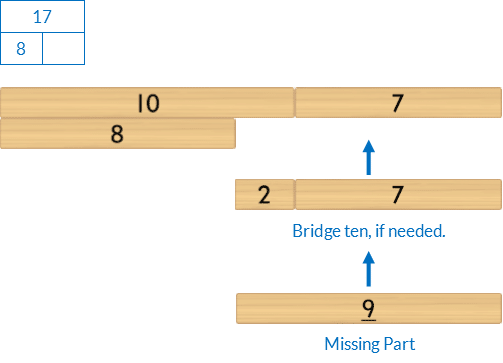66) Equation
Bonds of 11 to 20: Building

Mathematics
Apply the concept of related addition and subtraction equations, rearranged using the part-part-whole relationship, to find a missing part or whole.
Develop fluency recalling single-digit, two-part bonds of wholes 11 to 19.
(Where the part is greater than one and the commutative property is applied.)

This Equation Building activity combines Missing Number concepts. It is abstract, using only numbers, and assumes students have completed the Equation Building and Missing Number activities in previous chapters.
Please, click this link to read Teacher Notes for information about “Solving Missing Number Equations” using part-part-whole.
Language
- part-part-whole: where the two parts are a bond of the whole number
- missing (unknown) part
- missing (unknown) whole
- add
- subtract
- equals

Differentiation
A little easier
Equation Building
‘a little easier’ board coming soon…
Working Memory Support: build a bond
Use Bond Blocks to identify the missing number by representing both parts and the whole.
For example, to check a missing part

For example, to calculate a missing part

For example, to check a missing whole

Recall Practice: desk visual
Click to download Part-Part-Whole Blank Cards.

Students fill them in for the specific bonds they identified as still needing to develop fluency with.
- Cover different numbers to practice recall.

A little harder
Equations: part-part-whole rearranged
Write equations in an atypical order.
Whole = Part + Part
Part = Whole – Part

Click this link to read Teacher Notes for more information about “Atypical Arrangement using Part-Part-Whole” (pages 8-9).
Increase The Whole
Use Bond Blocks to represent part-part-whole for wholes in the twenties. Make related addition and subtraction equations. Then change these equations to missing number equations for other students to solve.

The same whole can be partitioned differently to create new equations.

Look for patterns in how these two different partitions are related.
- Which numbers increased/decreased? By how much? Why?
- Which numbers stayed the same?
- What would happen if the 19 was changed to 17? Why? Explain this using Bond Blocks
Progression
In the next activity, students apply the missing number concept to missing number addition and subtraction equations. Go to
Activity 67
Bonds of 11 to 20: Missing Number Equations, Racing Motorcycles

